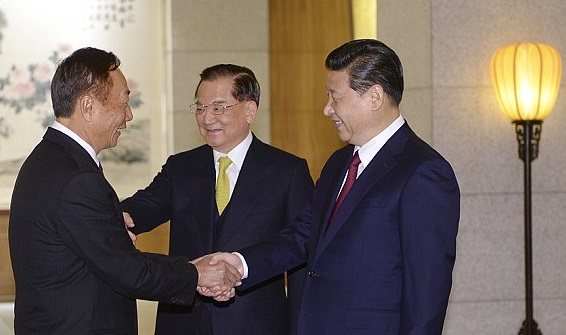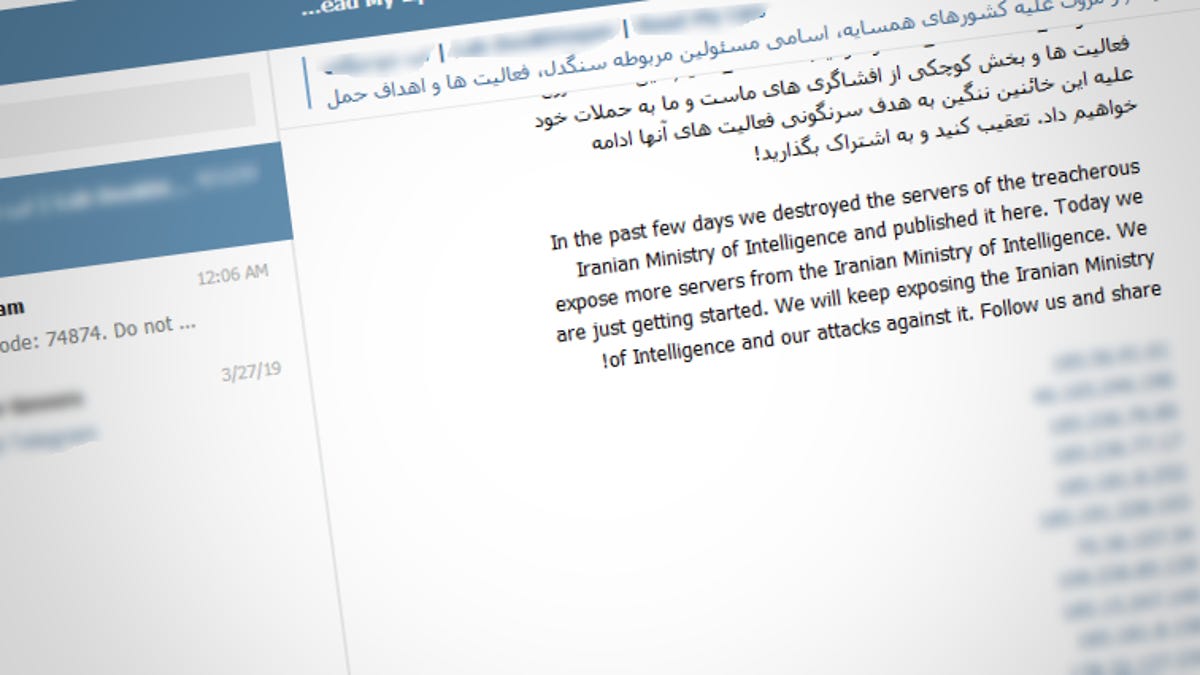Nokia-puhelimen vakoilutietolähetys Kiinaan - mikä ihmeen HMD Global?
23.3.2019 12:13
Ari Pesonen
3 kommenttia

Foxconnin Terry Gou (vas.) ja Kiina presidentti Xi Jinping hyvää pataa vuonna 2014.

Viime torstaina uutisoitiin laajasti norjalaisen yleisradioyhtiö NRK:n uutista, jonka mukaan suomalaisen HMD Global Oy:n valmistama Nokia 7 Plus -puhelinmalli on välittänyt puhelinkäyttäjän henkilökohtaisia tietoja kiinalaiselle palvelimelle (
NRKbeta 21.3.2019).
Kiinaan välitettyjä tietoja ovat olleet muun muassa puhelimen ja puhelimen käyttäjän maantieteellinen sijainti, puhelinliittymän SIM-kortin numero sekä puhelimen sarjanumero. Tiedot ovat siis luonteeltaan luottamuksellisia. Välitetyt tiedot täyttävät jopa vakoilutiedon määritelmän, ellei tiedon välitykselle ole ollut puhelimen käyttäjän lupaa.
Ja lupaahan ei ole ollut.
NRKbeta-sivuston mukaan Nokian 7 Plus -malli on suosittu Kiinassa. Se on itse asiassa Nokian suosituin malli. Vuonna 2018 myyntiin tulleen 7 Plus -mallin 250 000 puhelinta myytiin loppuun viidessä minuutissa.
NRKbeta-sivuston mukaan Nokia 7 Plus -puhelin on lähettänyt tiedot verkkotunnukseen
vnet.cn ja verkkotunnuksen takana on China Internet Network Information Center (
CNNIC), johon liittyy valtion enemmistöomisteinen China Telecom. CNNIC-sivujen
Introduction-valikosta ja sen
Policy and Resources Work Committee of Internet Society of China-alivalikosta saa kyllä käsityksen, mistä tässä kiinalaisessa hallinto- ja palveluorganisaatiossa on lopulta kysymys.
Eilen perjantaina NRKbeta-sivusto uutisoi lisäksi, että myös muut Nokian puhelinmallit lähettävät vastaavia tietoja Kiinaan kuin Nokia 7 Plus -puhelin. Kyse olisi puhelimen mukana tulevasta
autoregistration-sovelluksesta, joka lähettää salatun viestin
aps.c2dms.com-verkkotunnukselle, jonka omistaja on Shanghai Best Oray Information S&T Co., Ltd. (
NRKbeta 22.3.2019). Shanghai Best Oray Information S&T Co., Limitedillä (
kotisivut) on vajaat 40 000 verkkotunnusta. NRKbeta-sivusto ei ottanut kantaa, välittyykö Nokia-puhelimella imuroidut puhelimen käyttäjän luottamukselliset tiedot
aps.c2dms.com-verkkotunnuksen ja China Telecomin kautta Kiinan valtion CNNIC:lle.
Suomalainen HMD Global Oy (
kotisivut) on selitellyt tietojen päätymistä Kiinaan ohjelmistopaketin virheen vuoksi (
HS 21.3.2019):
”
Puhelintemme aktivointiohjelmisto, joka oli tarkoitettu käytettäväksi toisessa maassa, oli virheellisesti mukana yhden puhelinmallin yhden erän ohjelmistopaketissa. Virheestä johtuen puhelin on yrittänyt lähettää puhelimen aktivointitietoja kolmannen osapuolen palvelimelle.”
Tämä virhe on korjattu jo helmikuussa vaihtamalla oikea maaversioohjelmistopakettiin. Kaikkiin puhelimiin, joissa virhe oli, on lähetetty tämä korjaus. Melkein kaikki käyttäjät ovat asentaneet sen, mutta jos käyttäjä ei ole asiasta varma hänen kannattaa tarkistaa puhelimestaan, koska viimeinen päivitys on tehty.”
Mikä on tämä toinen maa? Tuohon suomalaiselta HMD Global Oy:ltä tulisi saada vastaus. Onko se Kiina, jossa Nokia-puhelin lähettää puhelimen käyttäjän luottamuksellisia tietoja sellaiselle verkkotunnukselle, jotka lopulta päätyvät ehkä CNNIC:n ja Kiinan valtion tietoon. Jos toinen maa ei ollut Kiina, miksi puhelin kuitenkin välitti puhelimen käyttäjän luottamukselliset tiedot Kiinaan?
Tapahtuuko samaa myös muun merkkisissä Kiinassa valmistetuissa puhelimissa, joissa on Kiinassa asennetut puhelinsovellukset. Viittaan vaikkapa Huaweihin. Jos turisti ostaa Kiinassa puhelimen ja tuo sen vaikkapa Suomeen, välittääkö puhelimen ohjelmisto puhelimen käyttäjän luottamuksellisia tietoja Kiinaan?
Kysymys nyt kuuluu, oliko Kiinan tarkoitus Nokian avustuksella kuitenkin saada
autoregistration-sovelluksella tietoja puhelimen länsimaisesta käyttäjästä Kiinaan? Jos kyseinen sovellus oli tarkoitettu vain Kiinan markkinoille, välitetäänkö Nokia-puhelimella kiinalaisten tietoja vastaavasti Kiinan valtiolle kuin mitä norjalaisten tietoja on välitetty?
Oliko Kiinaan tarkoitettuja puhelimia, joissa oli tämä ”ohjelmistopakettivirhe”, vahingossa päätynyt länsimaihin ja Norjaan vai oliko HMD Global Oy:n tarkoitus levittää Nokia 7 Plus -puhelimia vakoilusovelluksella länsimaihin ja kyseessä oli eräänlainen koe-erä tai koepallo?
Nuo ovat maallikon asettamia kysymyksiä, koska en ymmärrä tietotekniikasta paljon mitään.
Kiinnostava tässä on, miksi tiedot menivät juuri Kiinaan Kiinassa valmistetulla puhelimella, johon ladattu sovellukset Kiinassa. Miksi tietoja päätyi kaikista maailman maista juuri Kiinaan? Kommunistiseen Kiinaan, joka pyrkii valvomaan sekä omia kansalaisiaan että hankkimaan tietoa länsimaista länsimaihin toimittamilla telekommunikaatiolaitteillaan. Viittaan tällä Huaweihin, joka on ollut viime aikoina länsimaissa kovasti tapetilla etenkin 5G-verkon tietoturvakysymyksissä.
Jos olisin Suomen valtion tietoturvasta vastaava, Kiinassa valmistettuja ja ohjelmoituja puhelimia eikä muutakaan tietotekniikan laitteita ja ohjelmistoja kyllä valtion hallinnossa nähtäisi niin kauan kuin tällaisia ”ohjelmistopakettivirheitä” sattuu ja esiintyy.
****
HMD Global Oy on nimellisesti suomalainen yritys, jolle on lisensoitu Nokian puhelinten tavaramerkki. Microsoft myi vuonna 2016 peruspuhelinliiketoimintansa Foxconn Technology Groupin (Hon Hai Precision Industry Co., Ltd.,
kotisivut) tytäryhtiö FIH Mobile Limitedille sekä HMD Global Oy:lle 350 miljoonan Yhdysvaltain dollarin hintaan (
Microsoft 18.3.2016).
HMD Global Oy on merkitty Suomen kaupparekisteriin 17.11.2015, verohallinnon perustietoihin 19.11.2015 ja työnantajarekisteriin 1.8.2016. Yrityksellä on ollut liiketoiminnan arvonlisäverovelvollisuus 1.8.2016 alkaen. HMD Global Oy:n kaupparekisterimerkinnän ajankohdan perusteella Nokia-puhelinten kauppahieronta lienee ollut aktiivinen jo vuoden 2017 puolella.
HMD Global Oy:n hallituksen puheenjohtaja elokuusta 2018 alkaen on ollut Samuel Wai Leung Chin. Muut hallituksen jäsenet ovat Jean-Francois Bernard Marie Baril, Barry Hall French, Florian Seiche ja Pei-Chu Yeh. Hallituksen varajäsen on Jani Mikael Syrjänen, joka on myös yrityksen tietohallintojohtaja.
Yrityksen toimitusjohtaja vaihtui yllättäen kesällä 2017, kun Arto Nummelan korvasi Florian Seiche. Florian Seichen juuret ovat taiwanilaisessa älypuhelinten valmistaja HTC:ssä (
kotisivut).
HMD Global Oy:n hallituksen puheenjohtaja Samuel Wai Leung Chin oli Foxconn International Holdings Limitedin (
taustatietoja-1 ja
taustatietoja-2) hallituksen puheenjohtaja ja toimitusjohtaja vuoden 2013 alkuun saakka (
FIH, Changes executive deirector and chairman 13.12.2012).
Samuel Wai Leung Chin asustaa Kiinan Kawloonissa, joka on osa Kiinan Hong Kongia. Hong Kong oli myös Foxconn International Holdings Limitedin (FIH) kotipaikka. Samuel Wai Leung Chin sai käytännössä potkut Foxconnin tappioiden vuoksi ja Foxconn International Holdings Limitedin toimitusjohtajaksi valittiin Tong Wen-Hsi (
Reuters 13.12.2012). Foxconn International Holdings näki tappioiden takia loppunsa maaliskuussa 2013, jolloin yhtiöstä muodostetiin FIH Mobile Limited.
HMD Global Oy:n hallituksen jäsen Pei-Chu Yehin on puolestaan taiwanilainen ja hän on hongkongilaisen elektroniikkavalmistaja Proview International Holdingsin entinen johtaja. Proview International Holdingsin emo-organisaatio on puolestaan kiinalainen Shenzhen China Star Optoelectronics Technology Co., Ltd. (
kotisivut), jonka emoyhtiö puolestaan on TCL Corporation (
kotisivut). TCL Corporation on kiinalainen monikansallinen elektroniikkayhtiö.
Johtohenkilöiden taustoja ja vanhoja työtehtäviä on syytä käydä hieman läpi, koska ne usein selventävät heidän nykyisten toimien perusteita.
****
Nokia-puhelimet valmistaa fyysisesti siis taiwanilainen Foxconn Technology Groupiin (Hon Hai Precision Industry Co., Ltd.) kuuluva FIH Mobile Ltd. (
kotisivut). Nokia-puhelimet valmistetaan Kiinassa ja FIH Mobile Limitedin pääkonttori on manner-Kiinan Langfangissa.
Jatkossa käytän Foxconn Technology Groupista lyhyesti mainintaa Foxconn. FIH Mobile Limited on Foxconn (Far East) Limitedin tytäryhtiö, joka puolestaan toimii elektroniikkavalmistajien sijoitusyhtiöinä ollen puolestaan Hon Hai Precision Industry Co., Limitedin tytäryhtiö. Foxconnin kaikista yhtiöistä on välillä vaikea muodostaa selkeää hallintokuvaa.
Nokia-puhelinten suomalaisella HMD Global Oy:llä on siis vahva Kaukoitään ja Kiinaan liittyvä tausta sekä manner-Kiinan että Hong Kongin ja Taiwanin kautta. Hong Kong kuuluu Kiinaan ja Kiina pitää myös Taiwania Kiinaan kuuluvana.
Mielenkiintoinen kysymys on, ketkä omistavat HMD Global Oy:n ja mistä tulee ja on tullut yrityksen pääomarahoitus. Yrityksen liikevaihto vuonna 2017 oli hieman päälle 1,5 miljardia euroa, jolla yritys onnistui tekemään lähes 70 miljoonan euron tappion. Lyhyen historiansa aikana yritys ei ole toistaiseksi kyennyt tekemään voittoa.
HMD Global Oy:n takana on siis oltava tappioita sietävää pääomaa. Yksityishenkilöiden pääoma ei yleensä ole tappioita sietävää.
HMD Global Oy on ollut vaitonainen taustoistaan, mikä on herännyt aiheellisia kysymyksiä täällä Suomessa.
Taloussanomat uutisoi vuoden 2016 toukokuussa, ettei HMD Global Oy:n ja Nokia-puhelinten sijoittajajoukkoon eivät kuuluisi Nokia eikä Foxconn (
Taloussanomat 19.5.2016).
”
HMD:tä konsultoivan ja edustavan Brunswick-yhtiön edustaja tyrmää useissa medioissa esiintyneet väitteet yhtiön rahoittajista. Lausunnon mukaan HMD:tä ei omista Foxconn tai kukaan siellä työskentelevä henkilö.”, Taloussanomat kirjoitti.
Tuo oli jo vuonna 2016 virheellistä tietoa ja Brunswick-yhtiön edustaja puhui hieman muunneltua totuutta.
Tekniikka&Talous-lehden vuoden 2017 helmikuussa julkaistun jutun mukaan omistajina olisivat myös HMD:n avainhenkilöt (
T&T 26.2.2017). Tuo tieto on totta, kuten myöhemmin tässä kirjoituksessa käy ilmi.
****
Vielä viime vuonnakin suomalaiset talouslehdet - kuten Tekniikka&Talous - ovat kyselleet ahkerasti, kuka tai ketkä oikein omistavat ja rahoittavat HMD Global Oy:tä (
T&T 4.6.2018).
Keväällä 2018 HMD Global Oy järjesti uuden noin 100 miljoonan dollarin (noin 85 miljoonan euron) rahoituskierroksen. Pääoma oli tappiota tekevältä yritykseltä vähissä.
Vastauksia noihin kysymyksiin löytyy hieman FIH Mobile Limitedin laatimasta tiedotteesta Hong Kongin pörssiin, joka koskee HMD Global Oy:tä (
Discloseable transaction relating to subscription of convertible preferred shares in HMD Global Oy). Asiakirjan otsikko on vapaasti suomennettuna ”
Julkinen tiedote HMD Global Oy:n vaihtovelkakirjalainan merkitsemiseen liittyvistä liiketoimista”.
Tiedotteen mukaan HMD Global Oy:lle tuli keväällä 2018 kolme uutta sijoittajaa. Uusista vaihtovelkakirjalainasijoittajista Wonderful Stars Pte. Limited (
taustatietoja) sijoitti 62,0 miljoonaa dollaria, DMJ Asia Investment Opportunity Limited 3,0 miljoonaa dollaria ja Alpha Ginko Limited 35,573 miljoonaa dollaria. Uutta pääosaa tuli siis yhtiöön 100 573 000 dollaria.
Tosiallisesti Alpha Ginko Limitedin sijoitus on sen tytäryhtiön Ginko Venturesin (
kotisivut) nimissä. Wonderful Stars Pte. Limited on puolestaan Fuzhikang-konsernin (Guizhou Fuzhikang Precision Electronics Co.ltd.) tytäryhtiö. Fuzhikang-konsernista löytyvät puolestaan vanhat jäljet Foxconniin.
Vaihtovelkakirjalainassa sijoittajalla on laina-ajan päätyttyä oikeus halutessaan vaihtaa koko lainamäärä tai osa siitä yhtiön osakkeisiin ennalta määrätyn vaihtosuhteen mukaisesti. Osakkeenomistajien välisen sopimuksen sisältö löytyy edellä mainitun linkin pdf-tulosteesta. Sopimus on kirjattu päivämäärälle 21.3.2018.
Vanhat kolme omistajaa ennen omistuslaajennusta olivat asiakirjaan merkittyinä Smart Connect Investment S.a.r.l. (
taustatietoja), Asia-IO Special Opportunity 1, L.P. (
taustatietoja) ja Asia-IO Special Opportunity 1 Annex, L.P. (
taustatietoja).
S.a.r.l. = Société à responabilité limitée (yksityinen yritys ranskankielisissä maissa, jolla on rajallinen vastuu).
L.P. = Limited Partnership (rajallisen vastuun yritysmuoto, eräänlainen kommandiittiyhtiö).
Tiedotteen oli siis laatinut FIH Mobile Limited, joka on Wonderful Stars Pte. Limitedin emoyhtiö. FIH Mobile Limited sijoitti siis HMD Global Oy:hyn Wonderful Stars Pte. Limitedin kautta 62 miljoonaa dollaria. Kaikkiaan FIH Mobile Limited omistaa Wonderful Stars Pte. Limitedin kautta HMD Global Oy:tä noin 7 prosentin osuuden.
HMD Global Oy:n suurin omistaja on Smart Connect Investment S.a.r.l., jonka omistusosuus yhtiöstä yli puolet (noin 53 prosenttia) ja on siis enemmistöomistaja. Asia-IO Special Opportunity -yritysten omistusosuus on noin reilu kolmannes.
Alpha Ginko Limited on puolestaan eurooppalaistaustainen sijoittaja noin neljän prosentin osuudella.
HMD Global Oy:n ensiportaan sijoittajista on vaikea löytää tarkempaa julkista tietoa, mutta jotain kuitenkin löytyi. Kaikki kuusi yritystä tai rahastoa on rekisteröity joko Luxemburgissa ja Caymansaarilla lukuun ottamatta FIH Mobile Limitedin Wonderful Stars Pte. Limitediä. Smart Connect Investment S.a.r.l. on rekisteröity Luxemburgissa, kuten
taustatietoja-linkistä käy ilmi.
FIH Mobile omistaa 30 prosenttia Aasian-IO Special Opportunity 1 Annex L.P:stä, joka on siis yksi HMD:n osakkeenomistajista. HMD Global Oy:n vahva yritysomistajataho on siis ensimmäisen ja toisen omistajatason kautta FIH Mobile Limited.
FIH Mobile Limitedin ja HMD Global Oy omistusyhteydestä kertoo myös kirjaukset FIH Mobile Limitedin vuoden 2018 ennakkotulosjulkistuksessa (
Preliminary announcement of final results for the year ended 31 december 2018).
Jos edellä luetteloitu tuntui hieman vaikealta ymmärtää prosentteineen ensilukemalta, niin todettakoon lyhyesti, että Foxconnilla on siis vahva omistus ja sitä kautta vaikutusvalta HMD Global Oy:ssä.
****
Keitä henkilöitä sitten löytyy HMD Global Oy:n pääomarahastotyyppisistä omistajayrityksistä?
Ainoa henkilö, joka löytyy varmuudella Smart Connect Investment S.a.r.l. -yrityksen sekä myös Alpha Ginko Limited -yrityksen takaa, on Nokian hankintajohtajana vuosina 1999–2011 toiminut Jean-Francois Baril. Jean-Francois Baril löytyy myös HMD Global Oy:n sivuilta yrityksen johtajana ja perustajana (
HMD Global Oy, Jean-Francois Baril). Baril johtaa Smart Connect -rahastoa ja on Ginko Venturesin (
kotisivut) perustaja.
Ja yllätys, yllätys, Baril on toiminut myös Foxconnin toimitusjohtaja Terry Goun (kiinalaisittain Tai-Ming Gou) neuvonantajana. Barilista puhuttaessa Kauppalehden juttu vuodelta 2016 on syytä kerrata (
KL 19.5.2016).
Uskallan myös väittää, että HMD Global Oy:n hallituksen puheenjohtaja Samuel Wai Leung Chinillä on Jean-Francois Barilin tapaan omistusta HMD Global Oy:ssä ja hän toimii yhtiössä sijoittajana Foxconnista kerätyllä varallisuudellaan. Luottoa siis noilla kahdella herralla Nokia-puhelimeen tuntuu edelleen olevan.
Yle uutisoi - toki varmentamattomana tietona ja huhuna - Smart Connect Investment S.a.r.l. -rahaston yhden suuromistajan olevan Nokian entinen toimitusjohtaja Stephen Elop (
Yle 22.3.2019).
Sekä Samuel Wai Leung Chinillä että Jean-Francois Barililla on vahva rooli siihen, että Nokia-puhelimet päätyivät Nokiassa alasajoon ja loppujen lopuksi taiwanilaiselle Foxconnille. Barililla on vahva rooli Nokian puhelinten tuotannossa alihankinnan siirtäminen Suomesta taiwanilaiseen Foxconniin. Baril tekee nyt tiliä Foxconnilla.
Nokia-puhelin on nykyään yhtä kuin taiwanilainen Foxconn, mutta kysymys kuuluu, missä määrin kiinalaiset ovat mukana rahoittamassa Nokia-puhelimia ja missä rooleissa puhelimia manner-Kiinassa valmistetaan? Kiinalaiset ovat joka tapauksessa mukana.
Missä määrin kiinalaiset ovat olleet mahdollisesti asentamassa omin päin ”vahingossa” tai omistajiensa suostumuksella Nokia-puhelimiin ohjelmistojaan, jotka ovat lähettäneet puhelinten länsikäyttäjien luottamuksellisia tietoja Kiinaan? Kuinka kummassa on mahdollista, että Kiinassa valmistetuissa ja Norjaan tuoduissa puhelimissa on sovellus, joka on lähettänyt puhelinten käyttäjien luottamuksellisia tietoja Kiinaan?
****
Kuka omistaa HMD Global Oy:n osake-enemmistön omistavan Smart Connect Investment S.a.r.l. -yhtiön, jonka on siis HMD Global Oy:n enemmistöomistaja yli 50 prosentin omistusosuudella?
HMD Global Oy:n omistuksessa on joka tapauksessa vahva rooli FIH Mobile Limitedillä ja sen emoyhtiöllä Foxconn (Far East) Limitedillä ja edelleen Foxconn Technology Groupilla (Hon Hai Precision Industry Co., Limitedillä), mutta Smart Connect Investment S.a.r.l. -yhtiön omistuksessa on myös vahva manner-Kiinan osuus.
Jos FIH Mobile Limited ja sen omistusrakenne johtajineen kiinnostavat enemmän, voi tilannetta käydä tarkastelemassa esimerkiksi
Marketscreener, FIH Mobile Limited-sivustolta. Jos puolestaan Foxconn Technology Group (Hon Hai Precision Industry Co., Limited) kiinnostaa, tietoa löytyy
Marketscreener, Hon Hai Precision Industry Co., Limited-sivustolta.
Uskallan väittää, että juuri kiinalaisten vuoksi yrityksen omistus on haluttu pitää erityisen salaisena vastaavasti kuin Tallinna-tunnelin rakentamishankkeessa Touchstone Capital Partners -sijoitusyhtiön omistus. Kiinalaiset eivät aina halua pitää omistuksistaan kovaa ääntä.
Foxconnin yhtiöillä ja niiden johtajalla Terry Goulla on ollut viime aikoina entisestään lämpimämmät ja läheisemmät suhteen Kiinaan ja Kiinan korkeimpaan johtoon. Hyvä esimerkki on Foxconn Industrial Internet -yhtiön toiminta Kiinassa, vaikka yhtiö ei toistaiseksi olekaan ollut erityinen pörssimenestys.
Foxconn on myös Applen iPhone-puhelinten valmistaja. Applen on syytä olla varuillaan, ettei lopulta käy niin kuin Nokialle kävi, kun kommunistinen Kiina on ottamassa informaatiotekniikan valmistuskuvioissa laajempaa roolia hyvin määrätietoisella politiikalla. On syyttä nähdä myönteisenä, että Yhdysvaltain ja Kiina kauppasota on kuitenkin siirtämässä Foxconnin iPhone-puhelinten valmistusta myös Kiinan ulkopuolelle.
Kiinalainen digitaalisen vakoilun mahdollisuus on syytä ottaa vakavasti. Lenovosta en sano nyt yhtään mitään.
Viime torstaina uutisoitiin laajasti norjalaisen yleisradioyhtiö NRK:n uutista, jonka mukaan suomalaisen HMD Global Oy:n valmistama Nokia 7 Plus -puhelinmalli on välittänyt puhelinkäyttäjän…

aripesonen1.puheenvuoro.uusisuomi.fi







